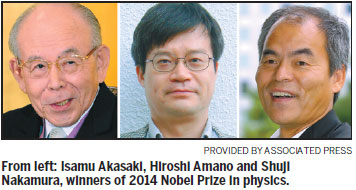Nobel Prize goes to inventors of LED lights
Isamu Akasaki and Hiroshi Amano of Japan and US scientist Shuji Nakamura won the Nobel Prize in physics on Tuesday for the invention of blue light-emitting diodes, a breakthrough that spurred the development of LED technology used to light up computer screens and modern smartphones.
The Royal Swedish Academy of Sciences said the invention is just 20 years old, "but it has already contributed to create white light in an entirely new manner to the benefit of us all".
Scientists had struggled for decades to produce the blue diodes that are a crucial component in producing white light from LEDs when the three laureates made their breakthroughs in the early 1990s.
"They succeeded where everyone else had failed. Incandescent light bulbs lit the 20th century; the 21st century will be lit by LED lamps," the Nobel committee said.
Akasaki, 85, is a professor at Meijo University and distinguished professor at Nagoya University. Amano, 54, is also a professor at Nagoya University, while the 60-year-old Nakamura is a Japanese-born professor at the University of California, Santa Barbara.
Akasaki said in a nationally-televised news conference that he had often been told that his research wouldn't bear fruit within the 20th century.

"But I never felt that way," he said. "I was just doing what I wanted to do."
Akasaki and Amano made their inventions while working at Nagoya University while Nakamura was working separately at Japanese company Nichia Chemicals. They built their own equipment and carried out thousands of experiments - many of which failed - before they made their breakthroughs.
In a statement from his university, Nakamura said he was honored to receive the prize.
"It is very satisfying to see that my dream of LED lighting has become a reality," he said. "I hope that energy-efficient LED light bulbs will help reduce energy use and lower the cost of lighting worldwide."
The Nobel committee said LEDs contribute to saving the Earth's resources because about one-fourth of world electricity consumption is used for lighting purposes.
They are more efficient than older light sources, and tend to last 10 times longer than fluorescent lamps and 100 times longer than incandescent light bulbs.
"The blue LED is a fundamental invention that that is rapidly changing the way we bring light to every corner of the home, the street and the workplace - a practical invention that comes from a fundamental understanding of physics in the solid state," said H. Frederick Dylla, the executive director and CEO of the American Institute of Physics.
AP - Reuters
(China Daily 10/08/2014 page10)








